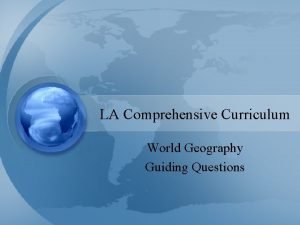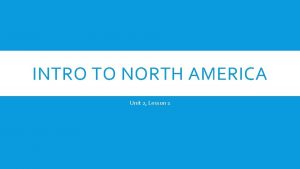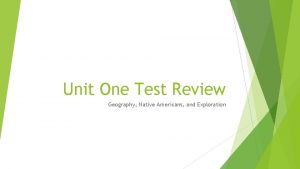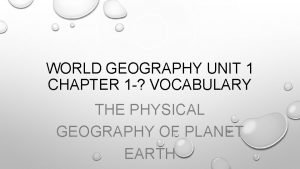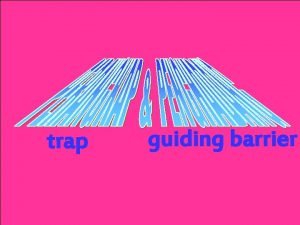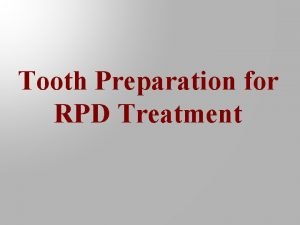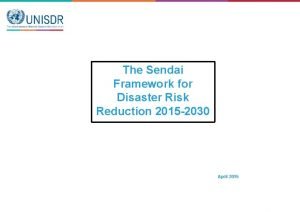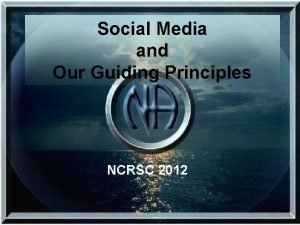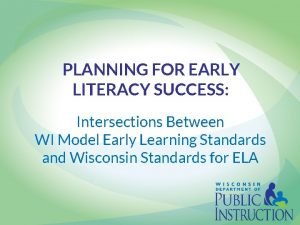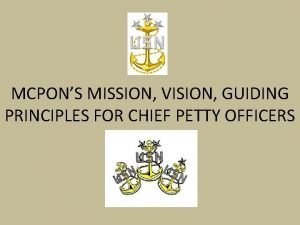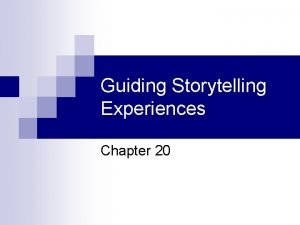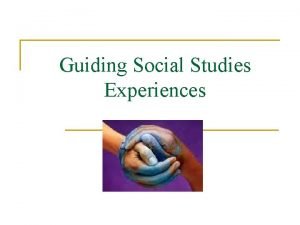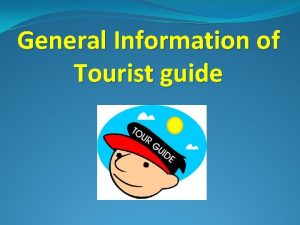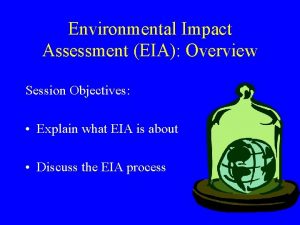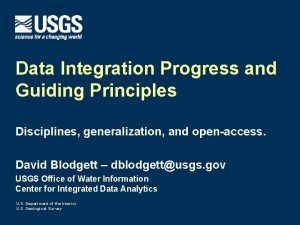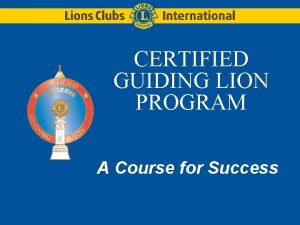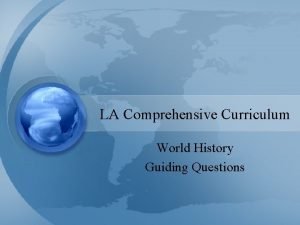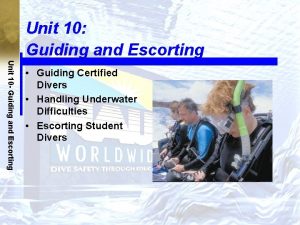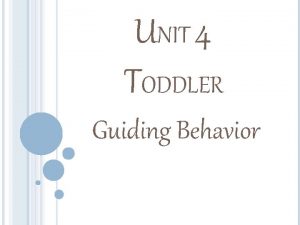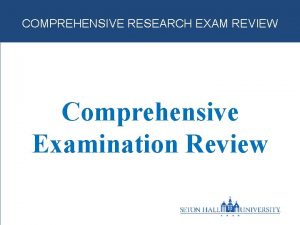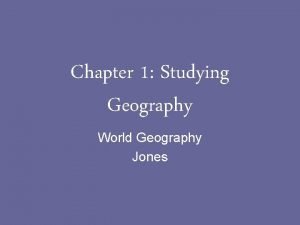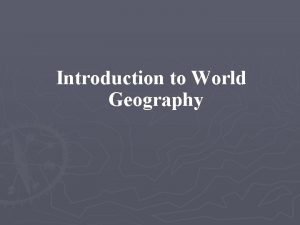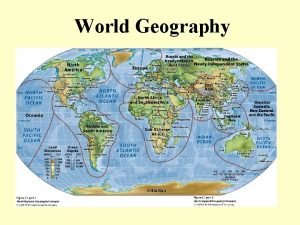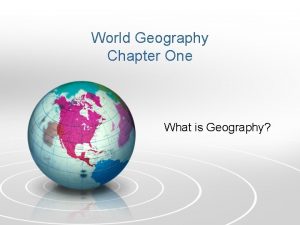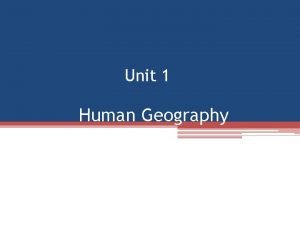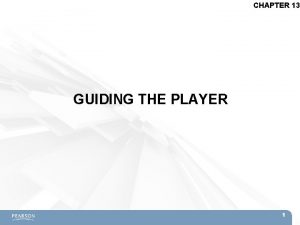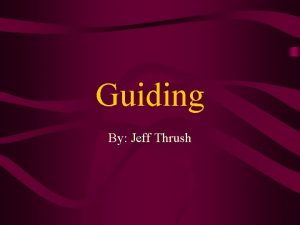LA Comprehensive Curriculum World Geography Guiding Questions Unit




























- Slides: 28

LA Comprehensive Curriculum World Geography Guiding Questions

Unit 1: Basic Geography Skills 1. Can students identify and use the map elements (map title, compass rose, scale, and legend, date, and author) to interpret data on a given map? 2. Can students use a compass rose to determine cardinal and intermediate directions on a map? 3. Can students use map symbols in a legend to interpret and analyze map information?

Unit 1: Basic Geography Skills Continued 4. Can students construct a map containing the necessary map elements based on given narrative information? 5. Can students identify various types of maps and their uses? 6. Can students explain the five themes of geography?

Unit 1: Basic Geography Skills Continued 7. Can students analyze, interpret, and apply information found on charts, diagrams, and graphs to explain geographic information? 8. Can students identify and explain the four components on Earth’s physical systems?

Unit 2: The U. S. and Canada 1. Can students identify and analyze the distinguishing physical or human features of the geographic regions of the U. S. and Canada? 2. Can students explain how topography, climate, soil, vegetation, and natural resources shaped the history of the U. S. and Canada?

Unit 2: U. S. and Canada Continued 3. Can students explain how location, physical features, and human characteristics of places influenced historical events in the regions? 4. Can students analyze the human activities and physical characteristics that led to regional labels? 5. Can students compare and contrast past and present trends in human migration with the U. S. ?

Unit 2: U. S. and Canada Continued 6. Can students analyze the relationship between a country’s standard of living and its locally accessible natural resources? 7. Can students debate a position on an environmental issue involving conservation or use of natural resources?

Unit 3: Central America, South America and the Caribbean 1. Can students apply the five themes of geography to the area of Latin America? 2. Can students draw conclusions about Latin America from its geographic or physical features? 3. Can students assess the role of government in preserving natural resources and protecting the natural environment?

Unit 3: Central America, South America and the Caribbean Cont. 4. Can students explain Latin America’s need for trade agreements? 5. Can students predict the future population of Latin America and the problems it will cause? 6. Can students assess the role of differing viewpoints in disputes over natural resources and territory?

Unit 4: Europe 1. Can students explain the ways in which regions of Europe are interconnected by trade? 2. Can students analyze or interpret a map of Europe to locate geographic information, using a variety of map elements? 3. Can students analyze regional issues and alliances in terms of common interests related to territory and resources in Europe?

Unit 4: Europe Continued 4. Can students compare, contrast, and analyze the economic power, military power, and population information in various countries and regions of Europe? 5. Can students explain how location, physical features, and human characteristics of places influenced historical events in Europe?

Unit 5: Russia and Northern Eurasia 1. Can students apply the five themes of geography to Russia and Northern Eurasia? 2. Can students construct a graph to display geographic information? 3. Can students analyze strategies to deal with environmental challenges in Russia and Northern Eurasia?

Unit 5: Russia and Northern Eurasia Continued 4. Can students describe how environmental challenges are posed by the physical environment or the impact of natural processes? 5. Can students compare, contrast, and analyze the distribution, growth rates, and other demographic characteristics of human populations in various countries or regions in Russia and Northern Eurasia?

Unit 5: Russia and Northern Eurasia Continued 6. Can students identify the distribution of economic systems in Russia and Northern Eurasia? 7. Can students analyze regional issues associated with territory and resources?

Unit 6: Middle East and North Africa 1. Can students apply the five themes of geography to the Middle East and North Africa? 2. Can students analyze strategies to deal with environmental challenges in the Middle East and North Africa? 3. Can students compare, contrast, and analyze the distribution, growth rates, and other demographic characteristics of human populations in various countries or regions in the Middle East and North Africa?

Unit 6: Middle East and North Africa Continued 4. Can students identify the distribution of natural resources in the Middle East and North Africa? 5. Can students analyze regional issues associated with the territory and resources in the Middle East and North Africa? 6. Can students draw conclusions about the Middle East and North Africa based on its geographic and physical features?

Unit 6: Middle East and North Africa Continued 7. Can students compare the role of culture in conflict and cooperation in the Middle East and North Africa?

Unit 7: Africa South of the Sahara 1. Can students apply the five themes of geography to Africa south of the Sahara? 2. Can students analyze social injustices occurring in Africa south of the Sahara and determine their impact on migration? 3. Can students compare, contrast, and analyze the economic systems and economic problems in Africa south of the Sahara?

Unit 7: Africa South of the Sahara Continued 4. Can students identify the distribution of climate regions in Africa south of the Sahara? 5. Can students analyze regional issues facing Africa south of the Sahara? 6. Can students identify and analyze the distinguishing physical or human characteristics of Africa south of the Sahara?

Unit 7: Africa South of the Sahara Continued 7. Can students evaluate how location, topography, climate, natural resources, and/or other physical characteristics affect human activities?

Unit 8: South Asia 1. Can students analyze or interpret a map of South Asia to locate geographic information using a variety of map elements? 2. Can students analyze regional issues and alliances in terms of common interests related to territory and resources in South Asia? 3. Can students compare and contract the impact of population density in South Asia?

Unit 8: South Asia Continued 4. Can students explain how location, physical features, and human characteristics of places influenced historical events in South Asia? 5. Can students examine the impact of physical processes on South Asia?

Unit 9: East and Southeast Asia 1. Can students explain the ways in which regions of East and Southeast Asia are interconnected by trade? 2. Can students analyze or interpret a map of East and Southeast Asia to locate geographic information, using a variety of map elements? 3. Can students analyze regional issues and alliances in terms of common interests related to territory and resources of East and Southeast Asia?

Unit 9: East and Southeast Asia Continued 4. Can students compare, contrast, and analyze the economic power, military power, and population information in various countries and regions of East and Southeast Asia? 5. Can students explain how location, physical features, and human characteristics of places influenced historical events in East and Southeast Asia?

Unit 9: East and Southeast Asia Continued 6. Can students analyze world regions based on given characteristics? 7. Can students analyze the distribution of natural resources in terms of import need and export capacity in East and Southeast Asia? 8. Can students analyze the relationship between a country’s standard of living and its locally accessible natural resources?

Unit 10: Australia and Oceania 1. Can students apply the five themes of geography to Australia and Oceania? 2. Can students draw conclusions about Australia and Oceania from their geographic or physical features? 3. Can students assess the role of government in preserving natural resources and protecting the natural environment?

Unit 10: Australia and Oceania Continued 4. Can students explain the impact of natural processes on Australia and Oceania? 5. Can students predict the future population of Australia and Oceania and the problems it will cause? 6. Can students assess the role of differing viewpoints in disputes over natural resources and territory? 7. Can students analyze the relationship between a country’s standard of living and its locally accessible natural resources?

Created for use by social studies teachers in the Lafayette Parish School System.
 Geography guiding questions
Geography guiding questions Guiding questions iron curtain speech
Guiding questions iron curtain speech Bias through selection and omission guiding questions
Bias through selection and omission guiding questions Economics unit 2 lesson 1
Economics unit 2 lesson 1 World geography unit 1 test
World geography unit 1 test World geography unit 1 vocabulary
World geography unit 1 vocabulary Unit 10, unit 10 review tests, unit 10 general test
Unit 10, unit 10 review tests, unit 10 general test Ap human geography frqs
Ap human geography frqs 5 themes of geography ap human geography
5 themes of geography ap human geography Stateless nation
Stateless nation Guiding barrier
Guiding barrier Canine cingulum rest
Canine cingulum rest Priority of sendai framework
Priority of sendai framework Na guiding principals
Na guiding principals 9 guiding principles wmels
9 guiding principles wmels Laws guiding book publishing in nigeria
Laws guiding book publishing in nigeria Systemic reforms of ncf 2005
Systemic reforms of ncf 2005 End goals of mtb-mle
End goals of mtb-mle Mcpon guiding principles 2021
Mcpon guiding principles 2021 Guiding storytelling experiences
Guiding storytelling experiences Importance of social science
Importance of social science Guiding play
Guiding play Guide plane in rpd
Guide plane in rpd In tour guiding, what is the expected objective
In tour guiding, what is the expected objective Eight guiding principles of eia
Eight guiding principles of eia Integration guiding principles
Integration guiding principles Certified guiding lion program
Certified guiding lion program This are guiding rules to follow
This are guiding rules to follow Org design guiding principles
Org design guiding principles
